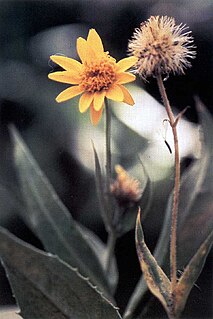
Chives, scientific name Allium schoenoprasum, is a species of flowering plant in the family Amaryllidaceae that produces edible leaves and flowers. Their close relatives include the common onions, garlic, shallot, leek, scallion, and Chinese onion.

Saxifraga is the largest genus in the family Saxifragaceae, containing about 465 species of holarctic perennial plants, known as saxifrages or rockfoils. The Latin word saxifraga means literally "stone-breaker", from Latin saxum + frangere. It is usually thought to indicate a medicinal use for treatment of urinary calculi, rather than breaking rocks apart.

Saxifraga cernua, the drooping saxifrage, nodding saxifrage or bulblet saxifrage, is a flower common all over the High Arctic. It stretches further south in mountainous areas of the Alps, Norway, Iceland, Siberia and Alaska.

Chrysosplenium is a genus of 57 species of flowering plant in the family Saxifragaceae. Species can be found throughout the Arctic and northern temperate parts of the Northern Hemisphere, with the highest species diversity in eastern Asia; two species are found disjunctly in South America.

Micranthes nivalis is a plant species in the saxifrage family. It is commonly called snow saxifrage or (ambiguously) alpine saxifrage.

Erigeron peregrinus is a North American species of flowering plants in the family Asteraceae known by the common name wandering fleabane.

Eriogonum wrightii is a species of wild buckwheat known by the common names bastardsage and Wright's buckwheat. It is native to the Southwestern United States, California, and northwest Mexico, where it grows in many plant communities, such as chaparral, in rocky habitats from mountains to deserts.

Chrysosplenium alternifolium is a species of flowering plant in the saxifrage family known as the alternate-leaved golden-saxifrage. It is a mat-forming perennial of wet places that grows between 5 and 15 cm tall. It blooms from March onward.

Vaccinium ovalifolium is a plant in the heath family having three varieties, all of which grow in northerly regions, including the subarctic.

Chrysosplenium iowense is a species of flowering plant in the saxifrage family known by the common name Iowa golden-saxifrage. It is native to North America, where it is "primarily a Canadian species", occurring from the northern Northwest Territories south to British Columbia and east to Manitoba. There are also disjunct, relictual occurrences within the United States, in the Driftless Area of Minnesota and Iowa.
Dianthus repens, common name boreal carnation or northern pink or cu jing shi zhu, is a plant species native to the Nei Mongol region of China, as well as to Siberia, the Russian Far East, northern parts of European Russia, Alaska and Yukon Territory.

Najas gracillima, the slender waternymph, is a submerged species of aquatic plant in the Hydrocharitaceae family. found in lakes and streams. It is native to China, Russian Far East, Japan, Korea, Taiwan, Iran, Alberta, Ontario, Newfoundland, Nova Scotia, New Brunswick, the eastern United States. It is also considered introduced and naturalized in France, Spain, Italy and California.

Galium kamtschaticum, known as Kamchatka bedstraw or boreal bedstraw, is a plant species in the Rubiaceae, named for the Kamchatka Peninsula on the Pacific Coast of Russia. The species is native to northeastern Asia and northern North America: Russia, northeastern China, Korea, Japan, Alaska, Canada, and the northern part of the contiguous United States.
Iris subg. Nepalensis is one subgenus of Iris, also known as 'Himalayan irises'. It was formerly genus Junopsis.

Iris setosa, the bristle-pointed iris, is a species of flowering plant in the genus Iris of the family Iridaceae, it belongs the subgenus Limniris and the series Tripetalae. It is a rhizomatous perennial from a wide range across the Arctic sea, including Alaska, Maine, Canada, Russia, northeastern Asia, China, Korea and southwards to Japan. The plant has tall branching stems, mid green leaves and violet, purple-blue, violet-blue, blue, to lavender flowers. There are also plants with pink and white flowers.

Arnica unalaschcensis is an Asian and North American species of flowering plant in the family Asteraceae, known as Alaskan arnica. It is found on both sides of the Bering Strait, being native to Alaska, the Pacific Coast of Russia, and northern Japan. Its habitats include coastal tundra and alpine slopes.

Arnica lanceolata is a North American species of flowering plant in the family Asteraceae, known by the common name clasping arnica or lanceleaf arnica. It has a disjunct (discontinuous) distribution in western North America and northeastern North America.
Cirsium kamtschaticum, the Kamchatka thistle, is an Alaskan and East Asian species of plants in the tribe Cardueae within the family Asteraceae. The species is found in eastern Russia, and on certain islands of the North Pacific: the Aleutian Islands of Alaska and Hokkaido Island in northern Japan.

Nymphaea tetragona is a species of flowering plant commonly called pigmy waterlily and small white water lily, belonging to the family Nymphaeaceae. In North America and Europe it native range is restricted to the boreal regions above 50° N latitude.
















